Shareholder and Stakeholder Theory: Impact on Corporate Governance
VerifiedAdded on 2020/05/04
|15
|4617
|129
Report
AI Summary
This report provides an analysis of shareholder and stakeholder theories within the context of corporate governance and social responsibility. It begins by outlining the core tenets of shareholder primacy, which emphasizes maximizing shareholder value, and the stakeholder approach, which prioritizes the interests of various stakeholders, including employees, customers, and the community. The report examines the perspectives of key figures such as Milton Friedman and R. Edward Freeman, highlighting the arguments for and against each theory. It explores the benefits of adopting a broader stakeholder view and discusses the impact of these theories on corporate practices. The report then delves into the application of these theories, offering recommendations for businesses to implement the most suitable approach based on their specific structure and objectives, emphasizing the importance of balancing profit maximization with stakeholder considerations. The report concludes that the stakeholder approach is more beneficial for a company.
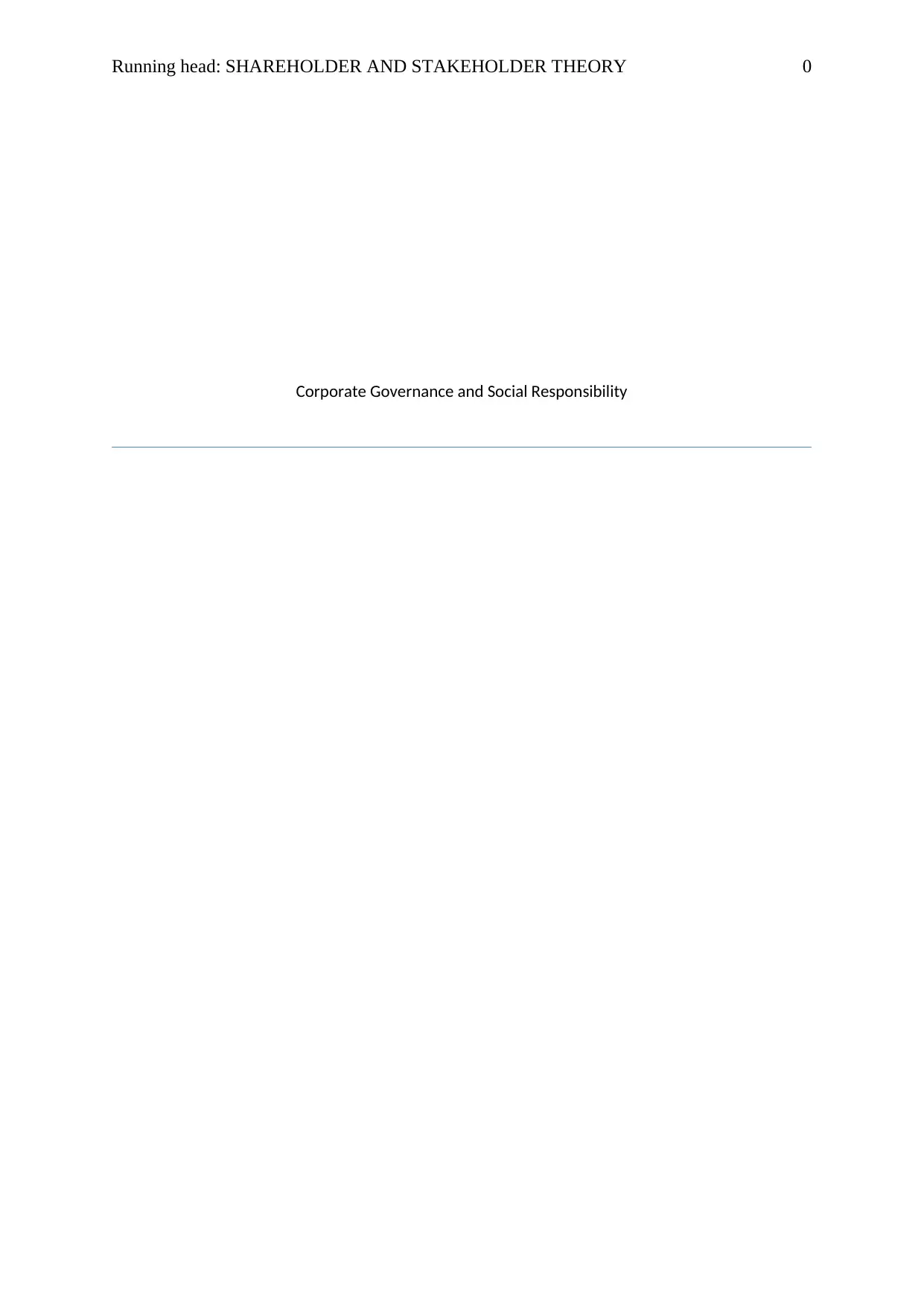
Running head: SHAREHOLDER AND STAKEHOLDER THEORY 0
Corporate Governance and Social Responsibility
Corporate Governance and Social Responsibility
Paraphrase This Document
Need a fresh take? Get an instant paraphrase of this document with our AI Paraphraser

SHAREHOLDER AND STAKEHOLDER THEORY 1
Executive Summary
The purpose of this report is to analyse various theories provided by different experts
regarding shareholder and stakeholder approach. The purpose of this report is to analyse the
value and impact of each theory in a corporation. A shareholder primacy theory focuses on
maximising the value of company’s stock to increase the worth of shareholders in the market.
The stakeholder approach focus on improvising the value of each stakeholder in an
organization. Milton Friedman has written a paper on the importance of shareholder primacy
theory and its role in the enhancement of company’s profit. R. Edward Freeman provided a
different view it his report which emphasis on the importance of stakeholders approach in the
modern world and its positive impact on firms growth. After analysing various moral theories
and experts opinions, it can be provided that stakeholder approach is more beneficial for a
company. A company is considered as a corporate citizen, and it has duties towards various
stakeholders, such responsibilities are necessary to be fulfilled by the corporation. The
stakeholder approach also benefits the company by enhancing the revenues of a firm and
improving their goodwill in the industry. Below are few suggestions for implementation of
stakeholder policy:
Before implementing a stakeholder theory, management is required to analyse their
business structure and different stakeholder’s requirements.
The theory must cover all the aspects of a company and must also focus on profit
maximisation.
The stakeholder strategy should assist company is fulfilling their stakeholder's
requirements and maximising their revenues.
Executive Summary
The purpose of this report is to analyse various theories provided by different experts
regarding shareholder and stakeholder approach. The purpose of this report is to analyse the
value and impact of each theory in a corporation. A shareholder primacy theory focuses on
maximising the value of company’s stock to increase the worth of shareholders in the market.
The stakeholder approach focus on improvising the value of each stakeholder in an
organization. Milton Friedman has written a paper on the importance of shareholder primacy
theory and its role in the enhancement of company’s profit. R. Edward Freeman provided a
different view it his report which emphasis on the importance of stakeholders approach in the
modern world and its positive impact on firms growth. After analysing various moral theories
and experts opinions, it can be provided that stakeholder approach is more beneficial for a
company. A company is considered as a corporate citizen, and it has duties towards various
stakeholders, such responsibilities are necessary to be fulfilled by the corporation. The
stakeholder approach also benefits the company by enhancing the revenues of a firm and
improving their goodwill in the industry. Below are few suggestions for implementation of
stakeholder policy:
Before implementing a stakeholder theory, management is required to analyse their
business structure and different stakeholder’s requirements.
The theory must cover all the aspects of a company and must also focus on profit
maximisation.
The stakeholder strategy should assist company is fulfilling their stakeholder's
requirements and maximising their revenues.
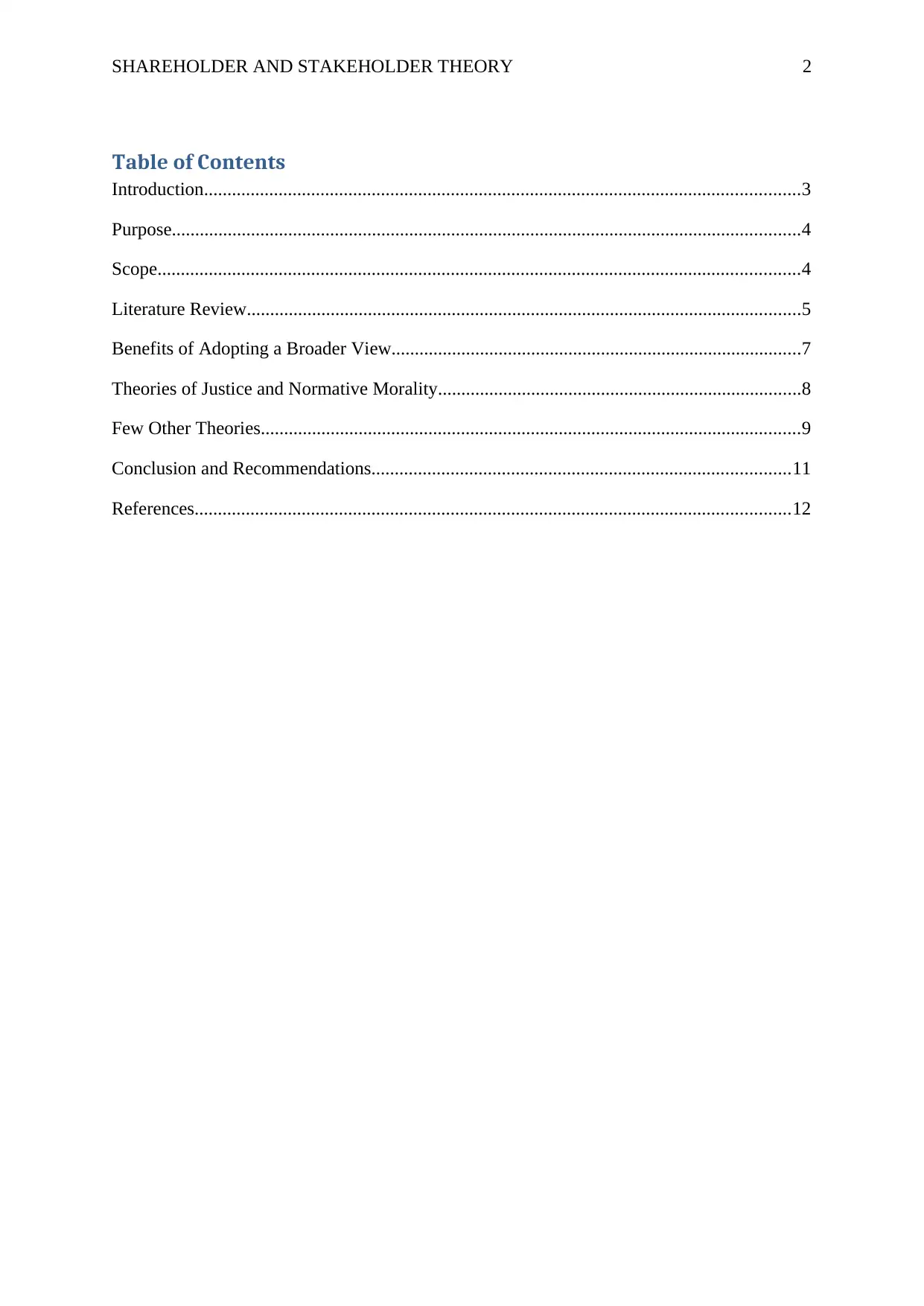
SHAREHOLDER AND STAKEHOLDER THEORY 2
Table of Contents
Introduction................................................................................................................................3
Purpose.......................................................................................................................................4
Scope..........................................................................................................................................4
Literature Review.......................................................................................................................5
Benefits of Adopting a Broader View........................................................................................7
Theories of Justice and Normative Morality..............................................................................8
Few Other Theories....................................................................................................................9
Conclusion and Recommendations..........................................................................................11
References................................................................................................................................12
Table of Contents
Introduction................................................................................................................................3
Purpose.......................................................................................................................................4
Scope..........................................................................................................................................4
Literature Review.......................................................................................................................5
Benefits of Adopting a Broader View........................................................................................7
Theories of Justice and Normative Morality..............................................................................8
Few Other Theories....................................................................................................................9
Conclusion and Recommendations..........................................................................................11
References................................................................................................................................12
⊘ This is a preview!⊘
Do you want full access?
Subscribe today to unlock all pages.

Trusted by 1+ million students worldwide

SHAREHOLDER AND STAKEHOLDER THEORY 3
Introduction
In recent years, the role of corporate social responsibility has grown significantly in between
companies; many organisations have adopted corporate social responsibility structure which
focuses on the interest of various stakeholders. Traditionally it was considered that a
company has a duty towards its shareholder to increase their value, the directors place
shareholders interest on top of everything in business. Due to globalisation and development
of industries, companies started adopting corporate social responsibility principles which
provide that a firm has duties towards its stakeholders. The stakeholder’s theory provides that
a managers’ role is to balance the shareholder’s monetary interest against other stakeholder’s
interest; a corporation’s stakeholders include employees, local community, consumers and
much more. Many experts believe that stakeholders’ theory is detrimental to a corporation’s
growth. If a company focus on the interest of its stakeholders, then it cannot achieve its
organisational objectives, which include expansion of business and enhancing shareholders
value in the market. Many experts have claimed that by focusing on increasing the value of
shareholders inevitably fulfills other stakeholders’ interest as well. The report will evaluate
opinions of various experts to understand the role of shareholder primacy and stakeholders
approach in a company.
Introduction
In recent years, the role of corporate social responsibility has grown significantly in between
companies; many organisations have adopted corporate social responsibility structure which
focuses on the interest of various stakeholders. Traditionally it was considered that a
company has a duty towards its shareholder to increase their value, the directors place
shareholders interest on top of everything in business. Due to globalisation and development
of industries, companies started adopting corporate social responsibility principles which
provide that a firm has duties towards its stakeholders. The stakeholder’s theory provides that
a managers’ role is to balance the shareholder’s monetary interest against other stakeholder’s
interest; a corporation’s stakeholders include employees, local community, consumers and
much more. Many experts believe that stakeholders’ theory is detrimental to a corporation’s
growth. If a company focus on the interest of its stakeholders, then it cannot achieve its
organisational objectives, which include expansion of business and enhancing shareholders
value in the market. Many experts have claimed that by focusing on increasing the value of
shareholders inevitably fulfills other stakeholders’ interest as well. The report will evaluate
opinions of various experts to understand the role of shareholder primacy and stakeholders
approach in a company.
Paraphrase This Document
Need a fresh take? Get an instant paraphrase of this document with our AI Paraphraser
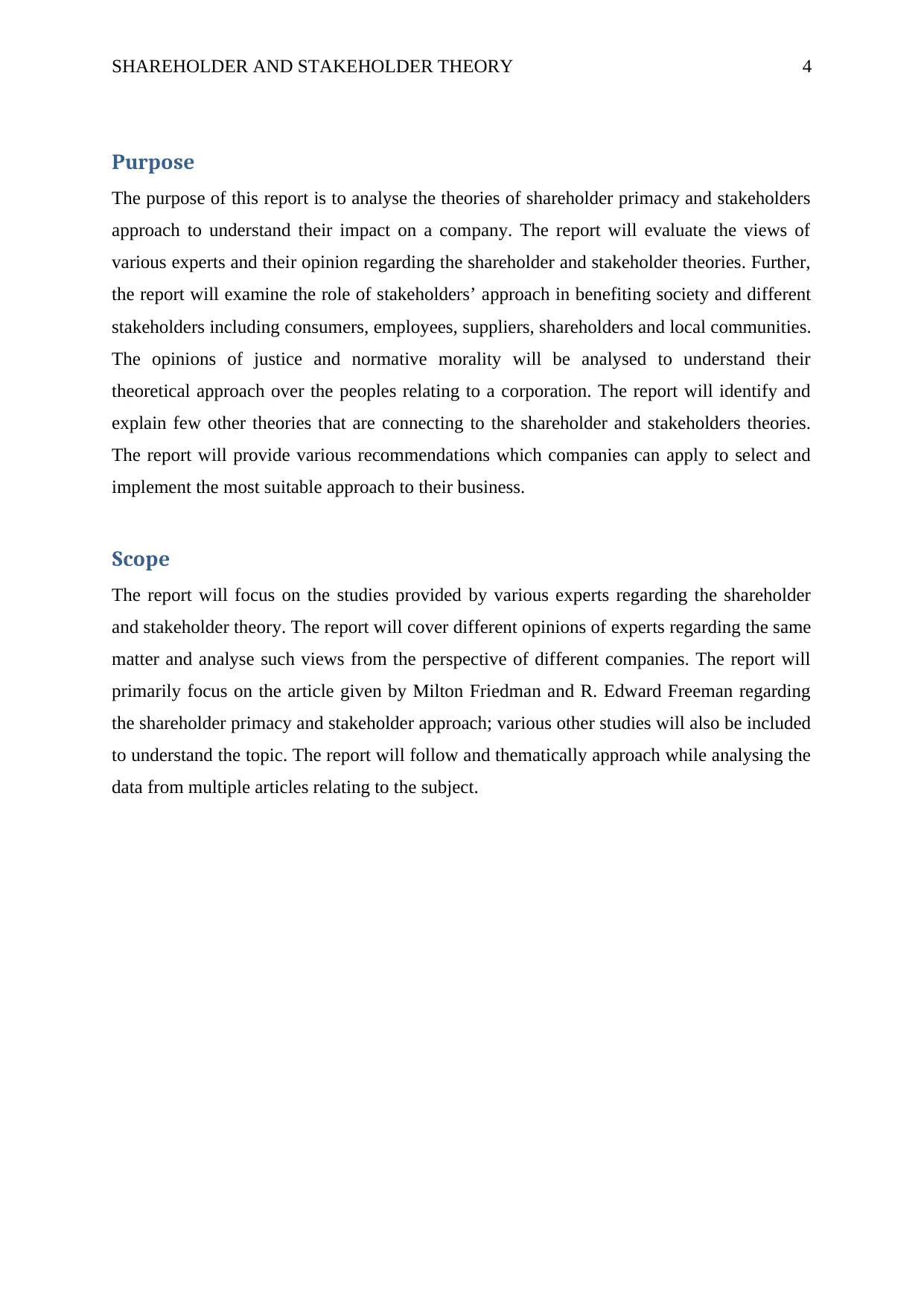
SHAREHOLDER AND STAKEHOLDER THEORY 4
Purpose
The purpose of this report is to analyse the theories of shareholder primacy and stakeholders
approach to understand their impact on a company. The report will evaluate the views of
various experts and their opinion regarding the shareholder and stakeholder theories. Further,
the report will examine the role of stakeholders’ approach in benefiting society and different
stakeholders including consumers, employees, suppliers, shareholders and local communities.
The opinions of justice and normative morality will be analysed to understand their
theoretical approach over the peoples relating to a corporation. The report will identify and
explain few other theories that are connecting to the shareholder and stakeholders theories.
The report will provide various recommendations which companies can apply to select and
implement the most suitable approach to their business.
Scope
The report will focus on the studies provided by various experts regarding the shareholder
and stakeholder theory. The report will cover different opinions of experts regarding the same
matter and analyse such views from the perspective of different companies. The report will
primarily focus on the article given by Milton Friedman and R. Edward Freeman regarding
the shareholder primacy and stakeholder approach; various other studies will also be included
to understand the topic. The report will follow and thematically approach while analysing the
data from multiple articles relating to the subject.
Purpose
The purpose of this report is to analyse the theories of shareholder primacy and stakeholders
approach to understand their impact on a company. The report will evaluate the views of
various experts and their opinion regarding the shareholder and stakeholder theories. Further,
the report will examine the role of stakeholders’ approach in benefiting society and different
stakeholders including consumers, employees, suppliers, shareholders and local communities.
The opinions of justice and normative morality will be analysed to understand their
theoretical approach over the peoples relating to a corporation. The report will identify and
explain few other theories that are connecting to the shareholder and stakeholders theories.
The report will provide various recommendations which companies can apply to select and
implement the most suitable approach to their business.
Scope
The report will focus on the studies provided by various experts regarding the shareholder
and stakeholder theory. The report will cover different opinions of experts regarding the same
matter and analyse such views from the perspective of different companies. The report will
primarily focus on the article given by Milton Friedman and R. Edward Freeman regarding
the shareholder primacy and stakeholder approach; various other studies will also be included
to understand the topic. The report will follow and thematically approach while analysing the
data from multiple articles relating to the subject.
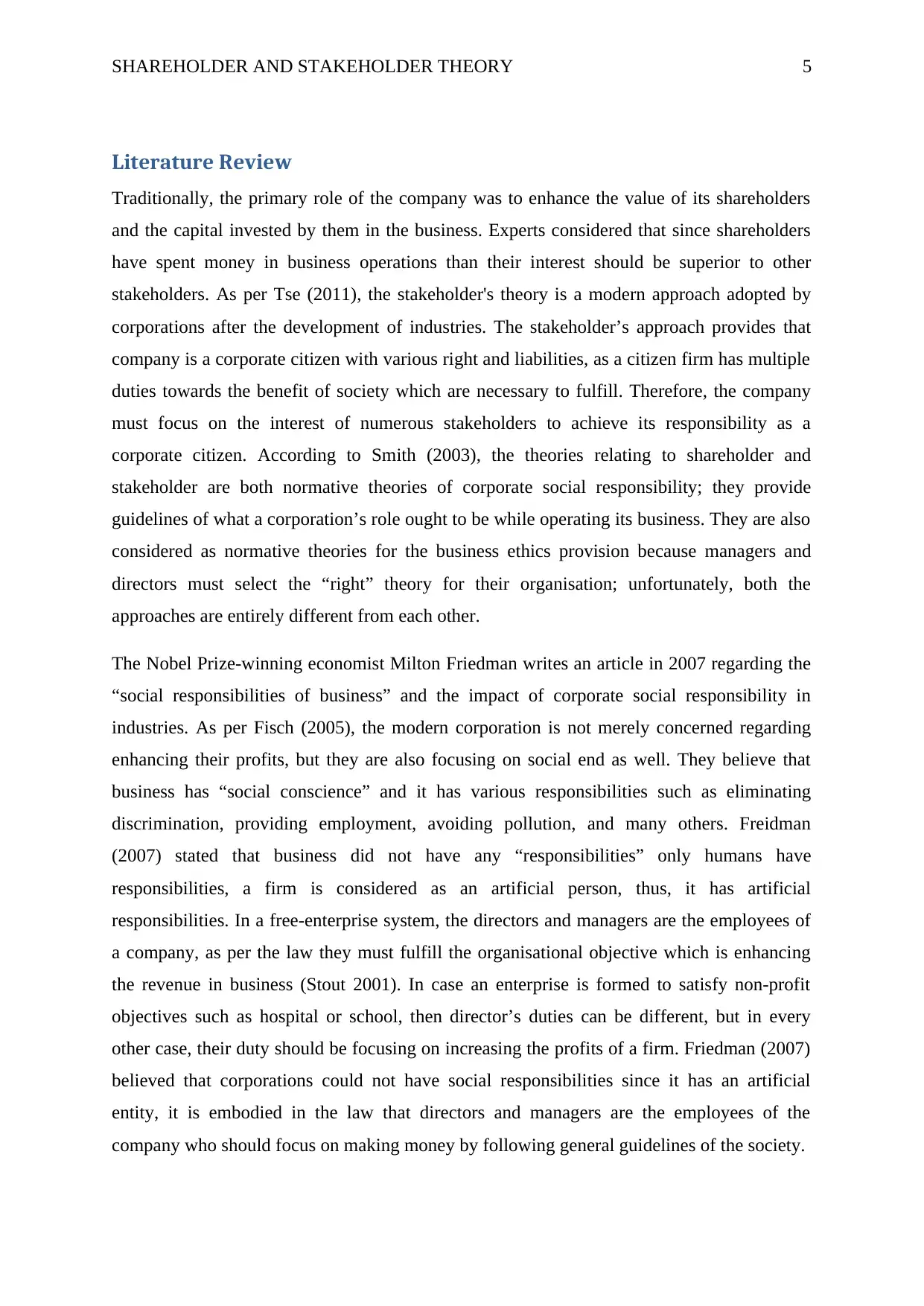
SHAREHOLDER AND STAKEHOLDER THEORY 5
Literature Review
Traditionally, the primary role of the company was to enhance the value of its shareholders
and the capital invested by them in the business. Experts considered that since shareholders
have spent money in business operations than their interest should be superior to other
stakeholders. As per Tse (2011), the stakeholder's theory is a modern approach adopted by
corporations after the development of industries. The stakeholder’s approach provides that
company is a corporate citizen with various right and liabilities, as a citizen firm has multiple
duties towards the benefit of society which are necessary to fulfill. Therefore, the company
must focus on the interest of numerous stakeholders to achieve its responsibility as a
corporate citizen. According to Smith (2003), the theories relating to shareholder and
stakeholder are both normative theories of corporate social responsibility; they provide
guidelines of what a corporation’s role ought to be while operating its business. They are also
considered as normative theories for the business ethics provision because managers and
directors must select the “right” theory for their organisation; unfortunately, both the
approaches are entirely different from each other.
The Nobel Prize-winning economist Milton Friedman writes an article in 2007 regarding the
“social responsibilities of business” and the impact of corporate social responsibility in
industries. As per Fisch (2005), the modern corporation is not merely concerned regarding
enhancing their profits, but they are also focusing on social end as well. They believe that
business has “social conscience” and it has various responsibilities such as eliminating
discrimination, providing employment, avoiding pollution, and many others. Freidman
(2007) stated that business did not have any “responsibilities” only humans have
responsibilities, a firm is considered as an artificial person, thus, it has artificial
responsibilities. In a free-enterprise system, the directors and managers are the employees of
a company, as per the law they must fulfill the organisational objective which is enhancing
the revenue in business (Stout 2001). In case an enterprise is formed to satisfy non-profit
objectives such as hospital or school, then director’s duties can be different, but in every
other case, their duty should be focusing on increasing the profits of a firm. Friedman (2007)
believed that corporations could not have social responsibilities since it has an artificial
entity, it is embodied in the law that directors and managers are the employees of the
company who should focus on making money by following general guidelines of the society.
Literature Review
Traditionally, the primary role of the company was to enhance the value of its shareholders
and the capital invested by them in the business. Experts considered that since shareholders
have spent money in business operations than their interest should be superior to other
stakeholders. As per Tse (2011), the stakeholder's theory is a modern approach adopted by
corporations after the development of industries. The stakeholder’s approach provides that
company is a corporate citizen with various right and liabilities, as a citizen firm has multiple
duties towards the benefit of society which are necessary to fulfill. Therefore, the company
must focus on the interest of numerous stakeholders to achieve its responsibility as a
corporate citizen. According to Smith (2003), the theories relating to shareholder and
stakeholder are both normative theories of corporate social responsibility; they provide
guidelines of what a corporation’s role ought to be while operating its business. They are also
considered as normative theories for the business ethics provision because managers and
directors must select the “right” theory for their organisation; unfortunately, both the
approaches are entirely different from each other.
The Nobel Prize-winning economist Milton Friedman writes an article in 2007 regarding the
“social responsibilities of business” and the impact of corporate social responsibility in
industries. As per Fisch (2005), the modern corporation is not merely concerned regarding
enhancing their profits, but they are also focusing on social end as well. They believe that
business has “social conscience” and it has various responsibilities such as eliminating
discrimination, providing employment, avoiding pollution, and many others. Freidman
(2007) stated that business did not have any “responsibilities” only humans have
responsibilities, a firm is considered as an artificial person, thus, it has artificial
responsibilities. In a free-enterprise system, the directors and managers are the employees of
a company, as per the law they must fulfill the organisational objective which is enhancing
the revenue in business (Stout 2001). In case an enterprise is formed to satisfy non-profit
objectives such as hospital or school, then director’s duties can be different, but in every
other case, their duty should be focusing on increasing the profits of a firm. Friedman (2007)
believed that corporations could not have social responsibilities since it has an artificial
entity, it is embodied in the law that directors and managers are the employees of the
company who should focus on making money by following general guidelines of the society.
⊘ This is a preview!⊘
Do you want full access?
Subscribe today to unlock all pages.

Trusted by 1+ million students worldwide
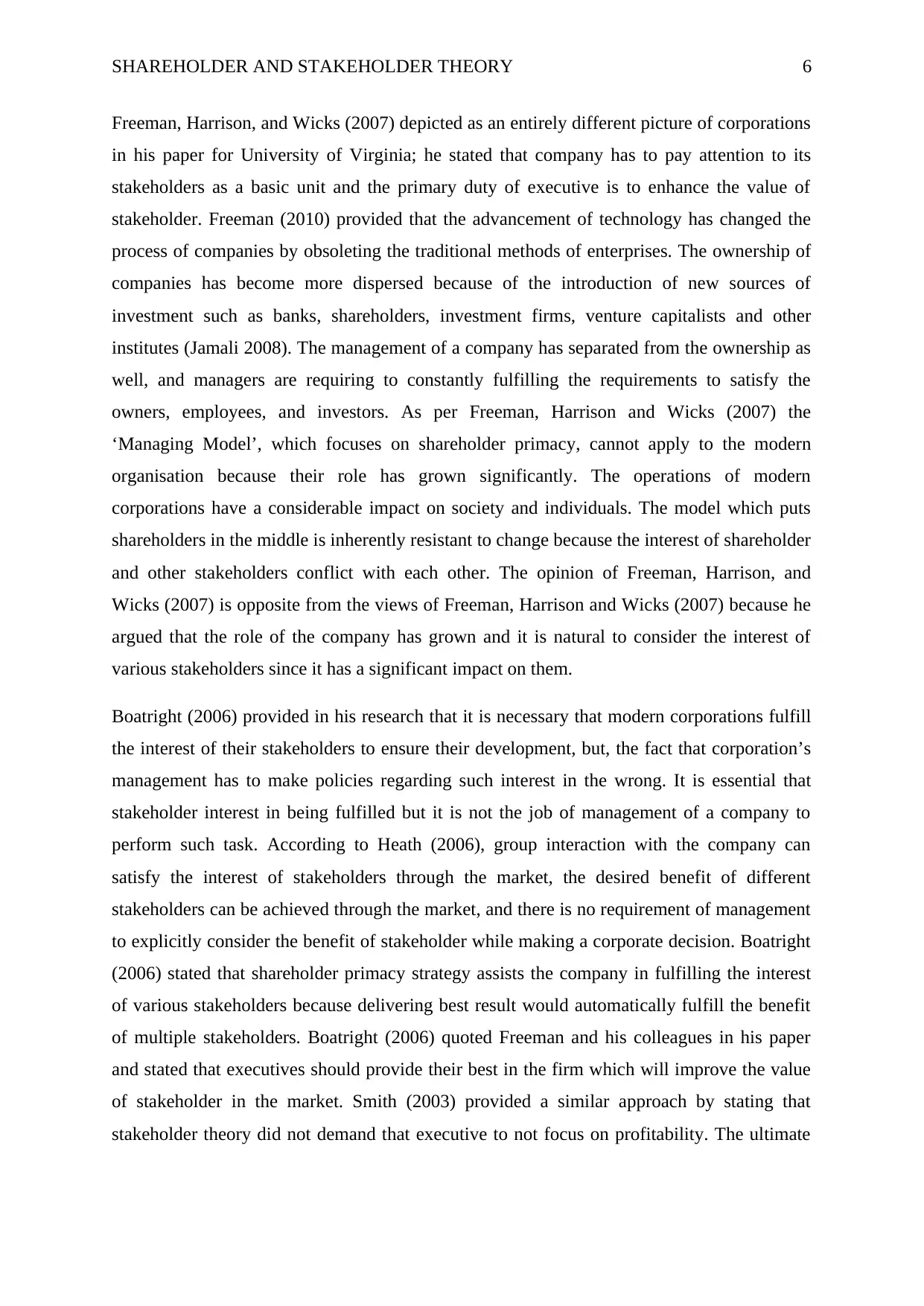
SHAREHOLDER AND STAKEHOLDER THEORY 6
Freeman, Harrison, and Wicks (2007) depicted as an entirely different picture of corporations
in his paper for University of Virginia; he stated that company has to pay attention to its
stakeholders as a basic unit and the primary duty of executive is to enhance the value of
stakeholder. Freeman (2010) provided that the advancement of technology has changed the
process of companies by obsoleting the traditional methods of enterprises. The ownership of
companies has become more dispersed because of the introduction of new sources of
investment such as banks, shareholders, investment firms, venture capitalists and other
institutes (Jamali 2008). The management of a company has separated from the ownership as
well, and managers are requiring to constantly fulfilling the requirements to satisfy the
owners, employees, and investors. As per Freeman, Harrison and Wicks (2007) the
‘Managing Model’, which focuses on shareholder primacy, cannot apply to the modern
organisation because their role has grown significantly. The operations of modern
corporations have a considerable impact on society and individuals. The model which puts
shareholders in the middle is inherently resistant to change because the interest of shareholder
and other stakeholders conflict with each other. The opinion of Freeman, Harrison, and
Wicks (2007) is opposite from the views of Freeman, Harrison and Wicks (2007) because he
argued that the role of the company has grown and it is natural to consider the interest of
various stakeholders since it has a significant impact on them.
Boatright (2006) provided in his research that it is necessary that modern corporations fulfill
the interest of their stakeholders to ensure their development, but, the fact that corporation’s
management has to make policies regarding such interest in the wrong. It is essential that
stakeholder interest in being fulfilled but it is not the job of management of a company to
perform such task. According to Heath (2006), group interaction with the company can
satisfy the interest of stakeholders through the market, the desired benefit of different
stakeholders can be achieved through the market, and there is no requirement of management
to explicitly consider the benefit of stakeholder while making a corporate decision. Boatright
(2006) stated that shareholder primacy strategy assists the company in fulfilling the interest
of various stakeholders because delivering best result would automatically fulfill the benefit
of multiple stakeholders. Boatright (2006) quoted Freeman and his colleagues in his paper
and stated that executives should provide their best in the firm which will improve the value
of stakeholder in the market. Smith (2003) provided a similar approach by stating that
stakeholder theory did not demand that executive to not focus on profitability. The ultimate
Freeman, Harrison, and Wicks (2007) depicted as an entirely different picture of corporations
in his paper for University of Virginia; he stated that company has to pay attention to its
stakeholders as a basic unit and the primary duty of executive is to enhance the value of
stakeholder. Freeman (2010) provided that the advancement of technology has changed the
process of companies by obsoleting the traditional methods of enterprises. The ownership of
companies has become more dispersed because of the introduction of new sources of
investment such as banks, shareholders, investment firms, venture capitalists and other
institutes (Jamali 2008). The management of a company has separated from the ownership as
well, and managers are requiring to constantly fulfilling the requirements to satisfy the
owners, employees, and investors. As per Freeman, Harrison and Wicks (2007) the
‘Managing Model’, which focuses on shareholder primacy, cannot apply to the modern
organisation because their role has grown significantly. The operations of modern
corporations have a considerable impact on society and individuals. The model which puts
shareholders in the middle is inherently resistant to change because the interest of shareholder
and other stakeholders conflict with each other. The opinion of Freeman, Harrison, and
Wicks (2007) is opposite from the views of Freeman, Harrison and Wicks (2007) because he
argued that the role of the company has grown and it is natural to consider the interest of
various stakeholders since it has a significant impact on them.
Boatright (2006) provided in his research that it is necessary that modern corporations fulfill
the interest of their stakeholders to ensure their development, but, the fact that corporation’s
management has to make policies regarding such interest in the wrong. It is essential that
stakeholder interest in being fulfilled but it is not the job of management of a company to
perform such task. According to Heath (2006), group interaction with the company can
satisfy the interest of stakeholders through the market, the desired benefit of different
stakeholders can be achieved through the market, and there is no requirement of management
to explicitly consider the benefit of stakeholder while making a corporate decision. Boatright
(2006) stated that shareholder primacy strategy assists the company in fulfilling the interest
of various stakeholders because delivering best result would automatically fulfill the benefit
of multiple stakeholders. Boatright (2006) quoted Freeman and his colleagues in his paper
and stated that executives should provide their best in the firm which will improve the value
of stakeholder in the market. Smith (2003) provided a similar approach by stating that
stakeholder theory did not demand that executive to not focus on profitability. The ultimate
Paraphrase This Document
Need a fresh take? Get an instant paraphrase of this document with our AI Paraphraser
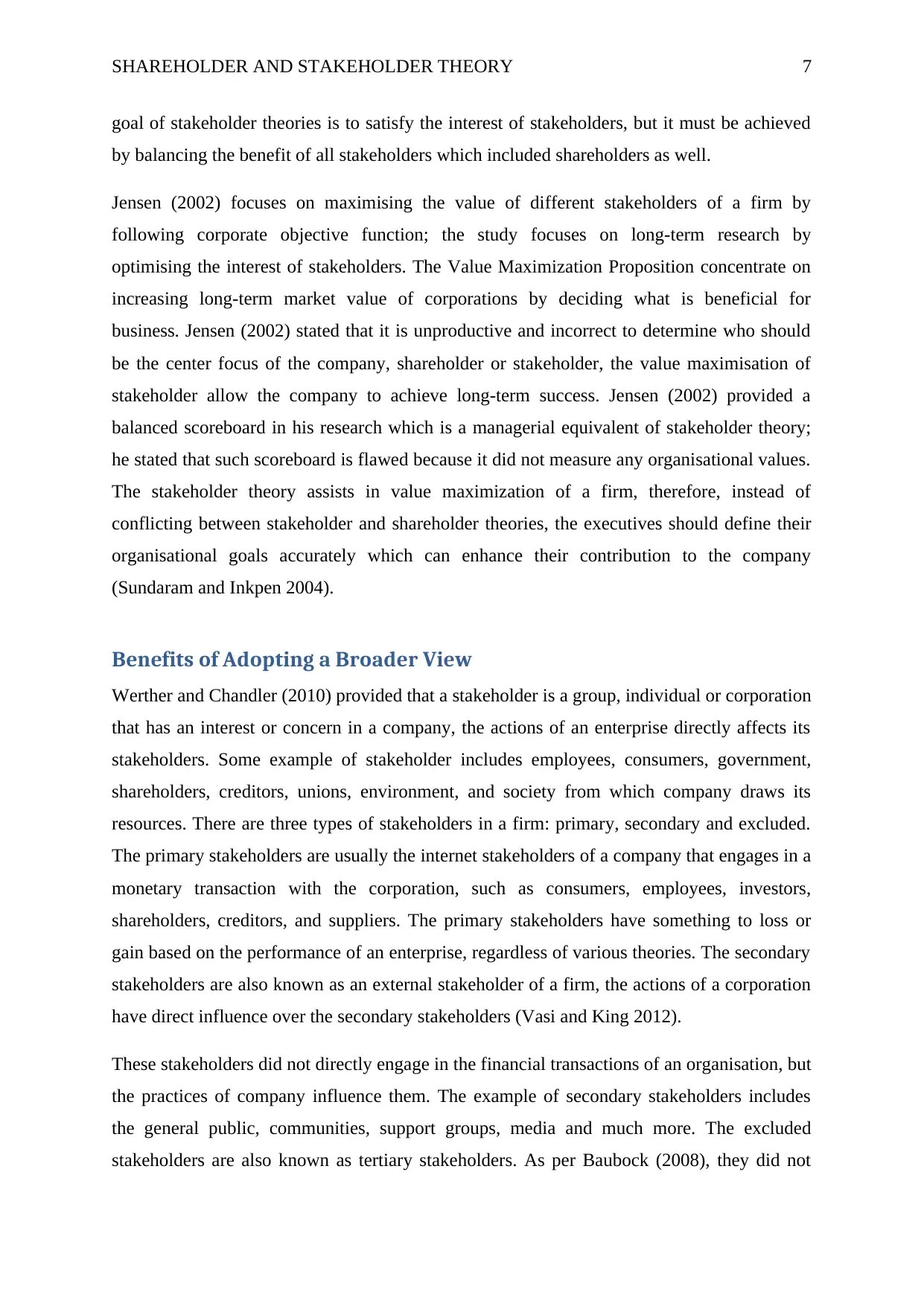
SHAREHOLDER AND STAKEHOLDER THEORY 7
goal of stakeholder theories is to satisfy the interest of stakeholders, but it must be achieved
by balancing the benefit of all stakeholders which included shareholders as well.
Jensen (2002) focuses on maximising the value of different stakeholders of a firm by
following corporate objective function; the study focuses on long-term research by
optimising the interest of stakeholders. The Value Maximization Proposition concentrate on
increasing long-term market value of corporations by deciding what is beneficial for
business. Jensen (2002) stated that it is unproductive and incorrect to determine who should
be the center focus of the company, shareholder or stakeholder, the value maximisation of
stakeholder allow the company to achieve long-term success. Jensen (2002) provided a
balanced scoreboard in his research which is a managerial equivalent of stakeholder theory;
he stated that such scoreboard is flawed because it did not measure any organisational values.
The stakeholder theory assists in value maximization of a firm, therefore, instead of
conflicting between stakeholder and shareholder theories, the executives should define their
organisational goals accurately which can enhance their contribution to the company
(Sundaram and Inkpen 2004).
Benefits of Adopting a Broader View
Werther and Chandler (2010) provided that a stakeholder is a group, individual or corporation
that has an interest or concern in a company, the actions of an enterprise directly affects its
stakeholders. Some example of stakeholder includes employees, consumers, government,
shareholders, creditors, unions, environment, and society from which company draws its
resources. There are three types of stakeholders in a firm: primary, secondary and excluded.
The primary stakeholders are usually the internet stakeholders of a company that engages in a
monetary transaction with the corporation, such as consumers, employees, investors,
shareholders, creditors, and suppliers. The primary stakeholders have something to loss or
gain based on the performance of an enterprise, regardless of various theories. The secondary
stakeholders are also known as an external stakeholder of a firm, the actions of a corporation
have direct influence over the secondary stakeholders (Vasi and King 2012).
These stakeholders did not directly engage in the financial transactions of an organisation, but
the practices of company influence them. The example of secondary stakeholders includes
the general public, communities, support groups, media and much more. The excluded
stakeholders are also known as tertiary stakeholders. As per Baubock (2008), they did not
goal of stakeholder theories is to satisfy the interest of stakeholders, but it must be achieved
by balancing the benefit of all stakeholders which included shareholders as well.
Jensen (2002) focuses on maximising the value of different stakeholders of a firm by
following corporate objective function; the study focuses on long-term research by
optimising the interest of stakeholders. The Value Maximization Proposition concentrate on
increasing long-term market value of corporations by deciding what is beneficial for
business. Jensen (2002) stated that it is unproductive and incorrect to determine who should
be the center focus of the company, shareholder or stakeholder, the value maximisation of
stakeholder allow the company to achieve long-term success. Jensen (2002) provided a
balanced scoreboard in his research which is a managerial equivalent of stakeholder theory;
he stated that such scoreboard is flawed because it did not measure any organisational values.
The stakeholder theory assists in value maximization of a firm, therefore, instead of
conflicting between stakeholder and shareholder theories, the executives should define their
organisational goals accurately which can enhance their contribution to the company
(Sundaram and Inkpen 2004).
Benefits of Adopting a Broader View
Werther and Chandler (2010) provided that a stakeholder is a group, individual or corporation
that has an interest or concern in a company, the actions of an enterprise directly affects its
stakeholders. Some example of stakeholder includes employees, consumers, government,
shareholders, creditors, unions, environment, and society from which company draws its
resources. There are three types of stakeholders in a firm: primary, secondary and excluded.
The primary stakeholders are usually the internet stakeholders of a company that engages in a
monetary transaction with the corporation, such as consumers, employees, investors,
shareholders, creditors, and suppliers. The primary stakeholders have something to loss or
gain based on the performance of an enterprise, regardless of various theories. The secondary
stakeholders are also known as an external stakeholder of a firm, the actions of a corporation
have direct influence over the secondary stakeholders (Vasi and King 2012).
These stakeholders did not directly engage in the financial transactions of an organisation, but
the practices of company influence them. The example of secondary stakeholders includes
the general public, communities, support groups, media and much more. The excluded
stakeholders are also known as tertiary stakeholders. As per Baubock (2008), they did not
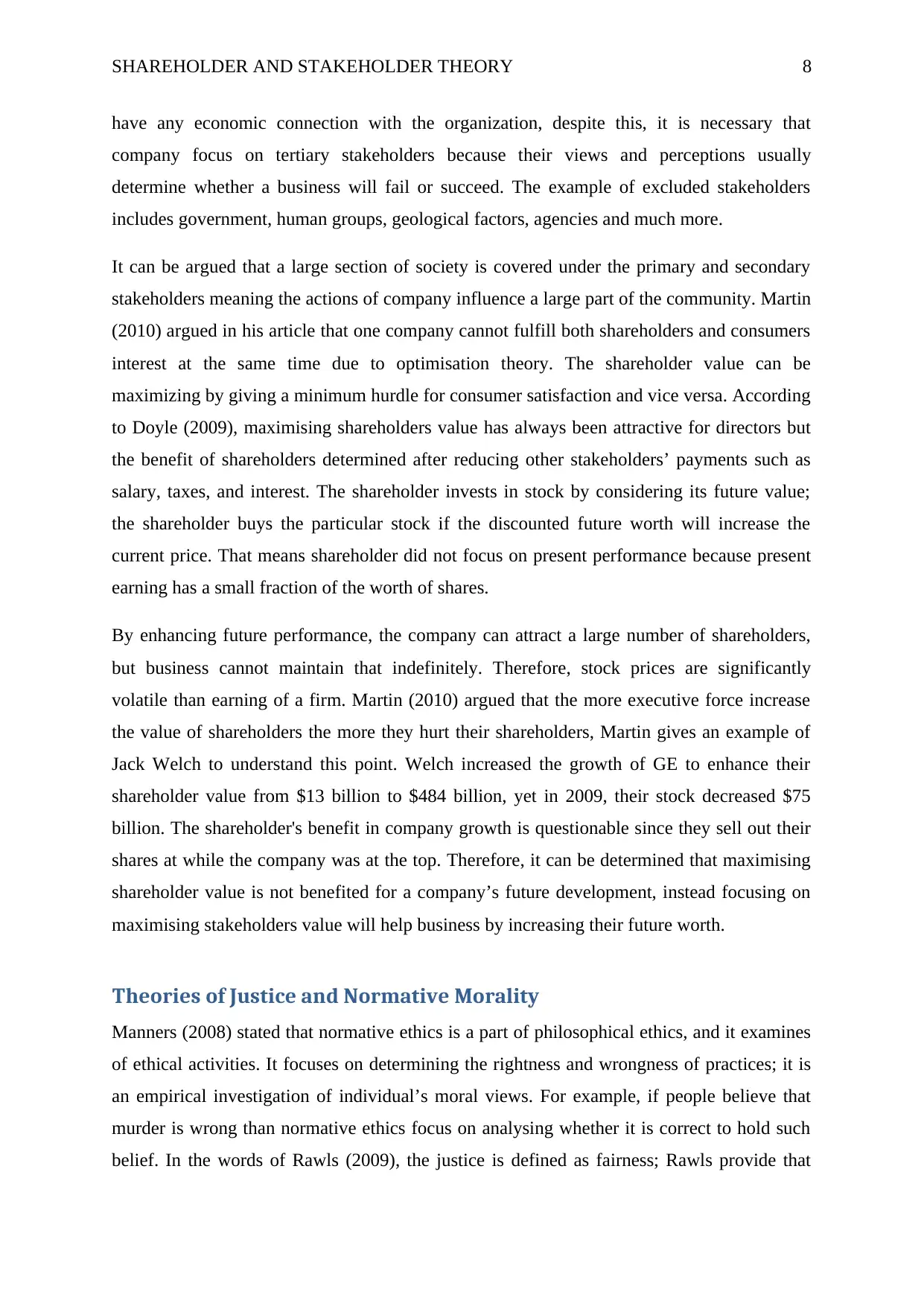
SHAREHOLDER AND STAKEHOLDER THEORY 8
have any economic connection with the organization, despite this, it is necessary that
company focus on tertiary stakeholders because their views and perceptions usually
determine whether a business will fail or succeed. The example of excluded stakeholders
includes government, human groups, geological factors, agencies and much more.
It can be argued that a large section of society is covered under the primary and secondary
stakeholders meaning the actions of company influence a large part of the community. Martin
(2010) argued in his article that one company cannot fulfill both shareholders and consumers
interest at the same time due to optimisation theory. The shareholder value can be
maximizing by giving a minimum hurdle for consumer satisfaction and vice versa. According
to Doyle (2009), maximising shareholders value has always been attractive for directors but
the benefit of shareholders determined after reducing other stakeholders’ payments such as
salary, taxes, and interest. The shareholder invests in stock by considering its future value;
the shareholder buys the particular stock if the discounted future worth will increase the
current price. That means shareholder did not focus on present performance because present
earning has a small fraction of the worth of shares.
By enhancing future performance, the company can attract a large number of shareholders,
but business cannot maintain that indefinitely. Therefore, stock prices are significantly
volatile than earning of a firm. Martin (2010) argued that the more executive force increase
the value of shareholders the more they hurt their shareholders, Martin gives an example of
Jack Welch to understand this point. Welch increased the growth of GE to enhance their
shareholder value from $13 billion to $484 billion, yet in 2009, their stock decreased $75
billion. The shareholder's benefit in company growth is questionable since they sell out their
shares at while the company was at the top. Therefore, it can be determined that maximising
shareholder value is not benefited for a company’s future development, instead focusing on
maximising stakeholders value will help business by increasing their future worth.
Theories of Justice and Normative Morality
Manners (2008) stated that normative ethics is a part of philosophical ethics, and it examines
of ethical activities. It focuses on determining the rightness and wrongness of practices; it is
an empirical investigation of individual’s moral views. For example, if people believe that
murder is wrong than normative ethics focus on analysing whether it is correct to hold such
belief. In the words of Rawls (2009), the justice is defined as fairness; Rawls provide that
have any economic connection with the organization, despite this, it is necessary that
company focus on tertiary stakeholders because their views and perceptions usually
determine whether a business will fail or succeed. The example of excluded stakeholders
includes government, human groups, geological factors, agencies and much more.
It can be argued that a large section of society is covered under the primary and secondary
stakeholders meaning the actions of company influence a large part of the community. Martin
(2010) argued in his article that one company cannot fulfill both shareholders and consumers
interest at the same time due to optimisation theory. The shareholder value can be
maximizing by giving a minimum hurdle for consumer satisfaction and vice versa. According
to Doyle (2009), maximising shareholders value has always been attractive for directors but
the benefit of shareholders determined after reducing other stakeholders’ payments such as
salary, taxes, and interest. The shareholder invests in stock by considering its future value;
the shareholder buys the particular stock if the discounted future worth will increase the
current price. That means shareholder did not focus on present performance because present
earning has a small fraction of the worth of shares.
By enhancing future performance, the company can attract a large number of shareholders,
but business cannot maintain that indefinitely. Therefore, stock prices are significantly
volatile than earning of a firm. Martin (2010) argued that the more executive force increase
the value of shareholders the more they hurt their shareholders, Martin gives an example of
Jack Welch to understand this point. Welch increased the growth of GE to enhance their
shareholder value from $13 billion to $484 billion, yet in 2009, their stock decreased $75
billion. The shareholder's benefit in company growth is questionable since they sell out their
shares at while the company was at the top. Therefore, it can be determined that maximising
shareholder value is not benefited for a company’s future development, instead focusing on
maximising stakeholders value will help business by increasing their future worth.
Theories of Justice and Normative Morality
Manners (2008) stated that normative ethics is a part of philosophical ethics, and it examines
of ethical activities. It focuses on determining the rightness and wrongness of practices; it is
an empirical investigation of individual’s moral views. For example, if people believe that
murder is wrong than normative ethics focus on analysing whether it is correct to hold such
belief. In the words of Rawls (2009), the justice is defined as fairness; Rawls provide that
⊘ This is a preview!⊘
Do you want full access?
Subscribe today to unlock all pages.

Trusted by 1+ million students worldwide
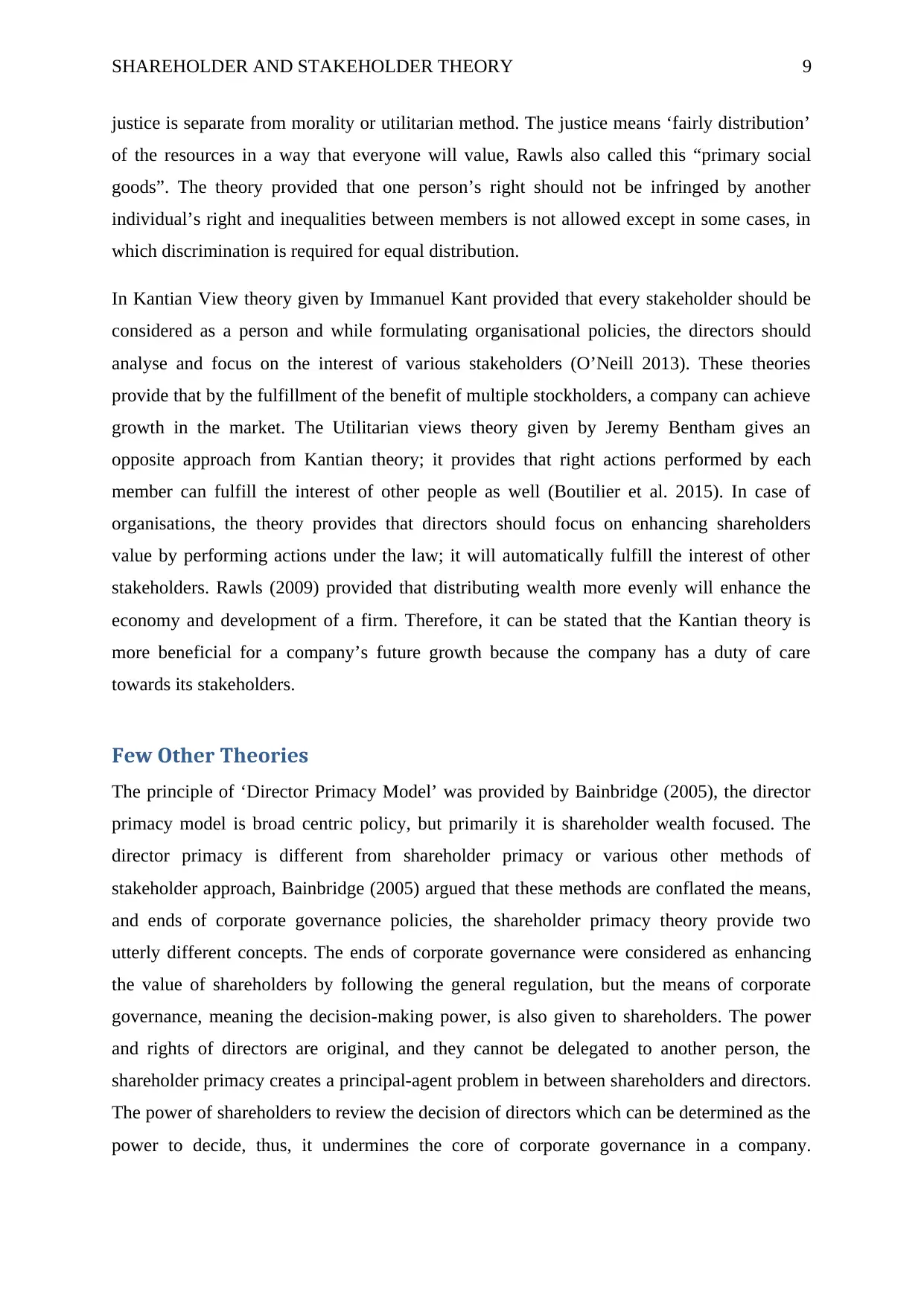
SHAREHOLDER AND STAKEHOLDER THEORY 9
justice is separate from morality or utilitarian method. The justice means ‘fairly distribution’
of the resources in a way that everyone will value, Rawls also called this “primary social
goods”. The theory provided that one person’s right should not be infringed by another
individual’s right and inequalities between members is not allowed except in some cases, in
which discrimination is required for equal distribution.
In Kantian View theory given by Immanuel Kant provided that every stakeholder should be
considered as a person and while formulating organisational policies, the directors should
analyse and focus on the interest of various stakeholders (O’Neill 2013). These theories
provide that by the fulfillment of the benefit of multiple stockholders, a company can achieve
growth in the market. The Utilitarian views theory given by Jeremy Bentham gives an
opposite approach from Kantian theory; it provides that right actions performed by each
member can fulfill the interest of other people as well (Boutilier et al. 2015). In case of
organisations, the theory provides that directors should focus on enhancing shareholders
value by performing actions under the law; it will automatically fulfill the interest of other
stakeholders. Rawls (2009) provided that distributing wealth more evenly will enhance the
economy and development of a firm. Therefore, it can be stated that the Kantian theory is
more beneficial for a company’s future growth because the company has a duty of care
towards its stakeholders.
Few Other Theories
The principle of ‘Director Primacy Model’ was provided by Bainbridge (2005), the director
primacy model is broad centric policy, but primarily it is shareholder wealth focused. The
director primacy is different from shareholder primacy or various other methods of
stakeholder approach, Bainbridge (2005) argued that these methods are conflated the means,
and ends of corporate governance policies, the shareholder primacy theory provide two
utterly different concepts. The ends of corporate governance were considered as enhancing
the value of shareholders by following the general regulation, but the means of corporate
governance, meaning the decision-making power, is also given to shareholders. The power
and rights of directors are original, and they cannot be delegated to another person, the
shareholder primacy creates a principal-agent problem in between shareholders and directors.
The power of shareholders to review the decision of directors which can be determined as the
power to decide, thus, it undermines the core of corporate governance in a company.
justice is separate from morality or utilitarian method. The justice means ‘fairly distribution’
of the resources in a way that everyone will value, Rawls also called this “primary social
goods”. The theory provided that one person’s right should not be infringed by another
individual’s right and inequalities between members is not allowed except in some cases, in
which discrimination is required for equal distribution.
In Kantian View theory given by Immanuel Kant provided that every stakeholder should be
considered as a person and while formulating organisational policies, the directors should
analyse and focus on the interest of various stakeholders (O’Neill 2013). These theories
provide that by the fulfillment of the benefit of multiple stockholders, a company can achieve
growth in the market. The Utilitarian views theory given by Jeremy Bentham gives an
opposite approach from Kantian theory; it provides that right actions performed by each
member can fulfill the interest of other people as well (Boutilier et al. 2015). In case of
organisations, the theory provides that directors should focus on enhancing shareholders
value by performing actions under the law; it will automatically fulfill the interest of other
stakeholders. Rawls (2009) provided that distributing wealth more evenly will enhance the
economy and development of a firm. Therefore, it can be stated that the Kantian theory is
more beneficial for a company’s future growth because the company has a duty of care
towards its stakeholders.
Few Other Theories
The principle of ‘Director Primacy Model’ was provided by Bainbridge (2005), the director
primacy model is broad centric policy, but primarily it is shareholder wealth focused. The
director primacy is different from shareholder primacy or various other methods of
stakeholder approach, Bainbridge (2005) argued that these methods are conflated the means,
and ends of corporate governance policies, the shareholder primacy theory provide two
utterly different concepts. The ends of corporate governance were considered as enhancing
the value of shareholders by following the general regulation, but the means of corporate
governance, meaning the decision-making power, is also given to shareholders. The power
and rights of directors are original, and they cannot be delegated to another person, the
shareholder primacy creates a principal-agent problem in between shareholders and directors.
The power of shareholders to review the decision of directors which can be determined as the
power to decide, thus, it undermines the core of corporate governance in a company.
Paraphrase This Document
Need a fresh take? Get an instant paraphrase of this document with our AI Paraphraser

SHAREHOLDER AND STAKEHOLDER THEORY 10
Therefore, the directory primacy model focuses on reducing the role of shareholders in the
corporate governance of a company.
According to Million (2010), the Enlightened shareholder value approach provides a similar
method as director primacy model, the theory state that director should be responsible for
promoting the success of a firm and the directors should determine various stakeholder's
relevancy. Both the theories mentioned above focus on directors rather than shareholder or
stakeholder for the growth of the company; they provide that directors play a crucial role in
corporate governance and development of a firm hence they should be at the center of a
corporation. Although these two theories provide a compelling argument, there are several
flaws in these theories. The director's primacy model provides that other stakeholders interest
is subordinate in a company, the directors will only consider stakeholder interest if it is by
shareholder interest (Reich-Graefe 2010). There is also lack of measuring director’s good
faith; in director primacy model executive might focus on their benefits. The interest of
creditors is also missing from the director enlightened shareholder approach. Due to these
flows, these theories are not beneficial for company’s future growth.
The Corporate Social Responsibility theory is a modern approach which is adopted by most
of the international companies; this method focuses on the role of the organisation as a
corporate citizen and provides various moral responsibilities which are required to be fulfilled
by the enterprise. According to Genasci and Pray (2008), the CSR theory focuses on
developing a company’s business by meeting the interest of different stakeholders. Most of
the multinational corporations have adopted this approach which benefits them by improving
their growth in international markets. Another similar theory is Creating Shared Value or
CSV; it creates a link between competitive advantage and CSR policies. CSV model provides
that companies can meet social requirement while operating in different markets, they assist
in the development of local businesses and refining the productivity in a value chain (Crane
et al. 2014). These theories benefit companies by improving their goodwill in the market
which automatically enhances their financial growth. Before adopting a stakeholder
approach, an organisation must analyse their corporate structure to formulate a policy which
is beneficial for them.
Therefore, the directory primacy model focuses on reducing the role of shareholders in the
corporate governance of a company.
According to Million (2010), the Enlightened shareholder value approach provides a similar
method as director primacy model, the theory state that director should be responsible for
promoting the success of a firm and the directors should determine various stakeholder's
relevancy. Both the theories mentioned above focus on directors rather than shareholder or
stakeholder for the growth of the company; they provide that directors play a crucial role in
corporate governance and development of a firm hence they should be at the center of a
corporation. Although these two theories provide a compelling argument, there are several
flaws in these theories. The director's primacy model provides that other stakeholders interest
is subordinate in a company, the directors will only consider stakeholder interest if it is by
shareholder interest (Reich-Graefe 2010). There is also lack of measuring director’s good
faith; in director primacy model executive might focus on their benefits. The interest of
creditors is also missing from the director enlightened shareholder approach. Due to these
flows, these theories are not beneficial for company’s future growth.
The Corporate Social Responsibility theory is a modern approach which is adopted by most
of the international companies; this method focuses on the role of the organisation as a
corporate citizen and provides various moral responsibilities which are required to be fulfilled
by the enterprise. According to Genasci and Pray (2008), the CSR theory focuses on
developing a company’s business by meeting the interest of different stakeholders. Most of
the multinational corporations have adopted this approach which benefits them by improving
their growth in international markets. Another similar theory is Creating Shared Value or
CSV; it creates a link between competitive advantage and CSR policies. CSV model provides
that companies can meet social requirement while operating in different markets, they assist
in the development of local businesses and refining the productivity in a value chain (Crane
et al. 2014). These theories benefit companies by improving their goodwill in the market
which automatically enhances their financial growth. Before adopting a stakeholder
approach, an organisation must analyse their corporate structure to formulate a policy which
is beneficial for them.
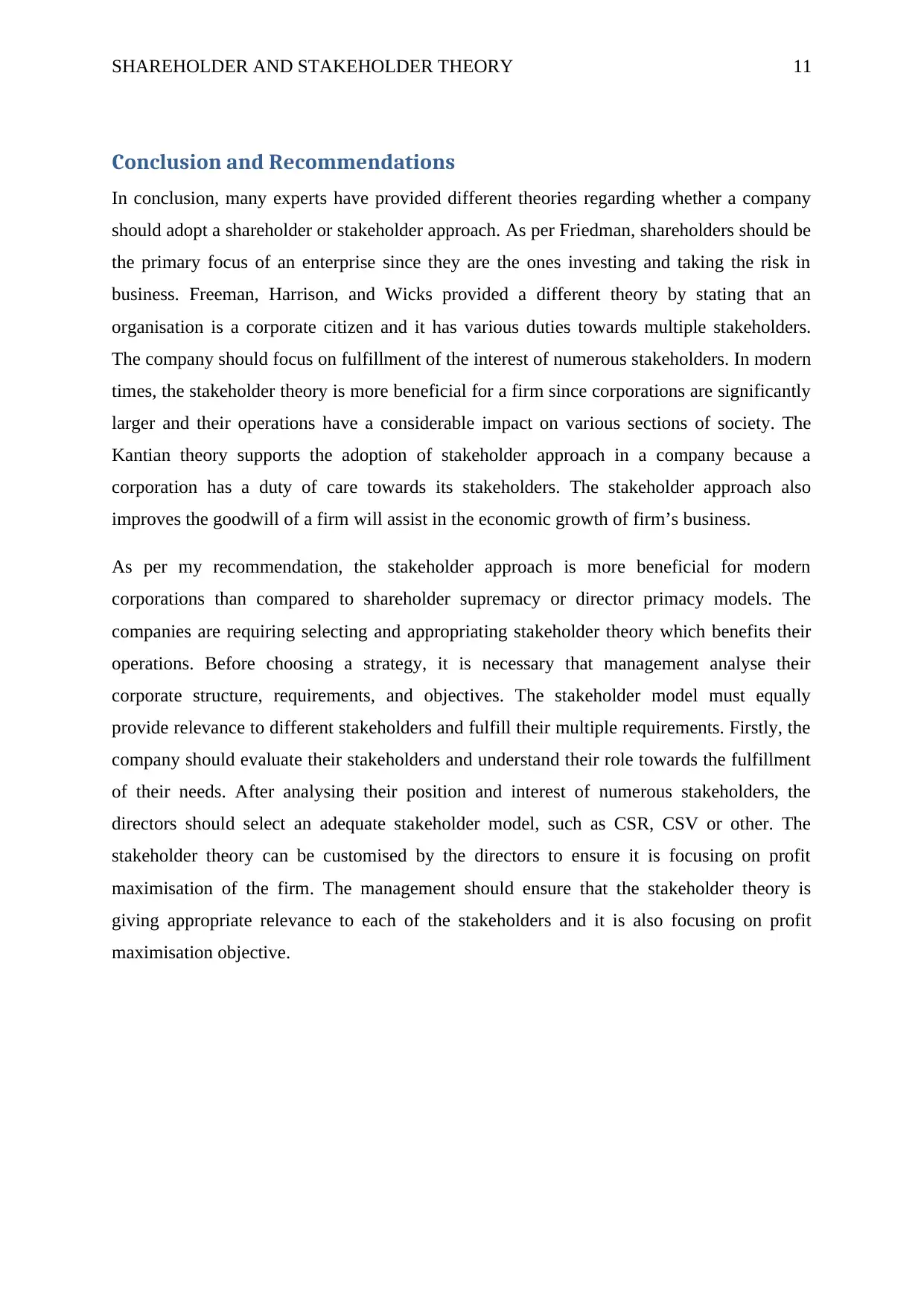
SHAREHOLDER AND STAKEHOLDER THEORY 11
Conclusion and Recommendations
In conclusion, many experts have provided different theories regarding whether a company
should adopt a shareholder or stakeholder approach. As per Friedman, shareholders should be
the primary focus of an enterprise since they are the ones investing and taking the risk in
business. Freeman, Harrison, and Wicks provided a different theory by stating that an
organisation is a corporate citizen and it has various duties towards multiple stakeholders.
The company should focus on fulfillment of the interest of numerous stakeholders. In modern
times, the stakeholder theory is more beneficial for a firm since corporations are significantly
larger and their operations have a considerable impact on various sections of society. The
Kantian theory supports the adoption of stakeholder approach in a company because a
corporation has a duty of care towards its stakeholders. The stakeholder approach also
improves the goodwill of a firm will assist in the economic growth of firm’s business.
As per my recommendation, the stakeholder approach is more beneficial for modern
corporations than compared to shareholder supremacy or director primacy models. The
companies are requiring selecting and appropriating stakeholder theory which benefits their
operations. Before choosing a strategy, it is necessary that management analyse their
corporate structure, requirements, and objectives. The stakeholder model must equally
provide relevance to different stakeholders and fulfill their multiple requirements. Firstly, the
company should evaluate their stakeholders and understand their role towards the fulfillment
of their needs. After analysing their position and interest of numerous stakeholders, the
directors should select an adequate stakeholder model, such as CSR, CSV or other. The
stakeholder theory can be customised by the directors to ensure it is focusing on profit
maximisation of the firm. The management should ensure that the stakeholder theory is
giving appropriate relevance to each of the stakeholders and it is also focusing on profit
maximisation objective.
Conclusion and Recommendations
In conclusion, many experts have provided different theories regarding whether a company
should adopt a shareholder or stakeholder approach. As per Friedman, shareholders should be
the primary focus of an enterprise since they are the ones investing and taking the risk in
business. Freeman, Harrison, and Wicks provided a different theory by stating that an
organisation is a corporate citizen and it has various duties towards multiple stakeholders.
The company should focus on fulfillment of the interest of numerous stakeholders. In modern
times, the stakeholder theory is more beneficial for a firm since corporations are significantly
larger and their operations have a considerable impact on various sections of society. The
Kantian theory supports the adoption of stakeholder approach in a company because a
corporation has a duty of care towards its stakeholders. The stakeholder approach also
improves the goodwill of a firm will assist in the economic growth of firm’s business.
As per my recommendation, the stakeholder approach is more beneficial for modern
corporations than compared to shareholder supremacy or director primacy models. The
companies are requiring selecting and appropriating stakeholder theory which benefits their
operations. Before choosing a strategy, it is necessary that management analyse their
corporate structure, requirements, and objectives. The stakeholder model must equally
provide relevance to different stakeholders and fulfill their multiple requirements. Firstly, the
company should evaluate their stakeholders and understand their role towards the fulfillment
of their needs. After analysing their position and interest of numerous stakeholders, the
directors should select an adequate stakeholder model, such as CSR, CSV or other. The
stakeholder theory can be customised by the directors to ensure it is focusing on profit
maximisation of the firm. The management should ensure that the stakeholder theory is
giving appropriate relevance to each of the stakeholders and it is also focusing on profit
maximisation objective.
⊘ This is a preview!⊘
Do you want full access?
Subscribe today to unlock all pages.

Trusted by 1+ million students worldwide
1 out of 15
Related Documents
Your All-in-One AI-Powered Toolkit for Academic Success.
+13062052269
info@desklib.com
Available 24*7 on WhatsApp / Email
![[object Object]](/_next/static/media/star-bottom.7253800d.svg)
Unlock your academic potential
Copyright © 2020–2025 A2Z Services. All Rights Reserved. Developed and managed by ZUCOL.





